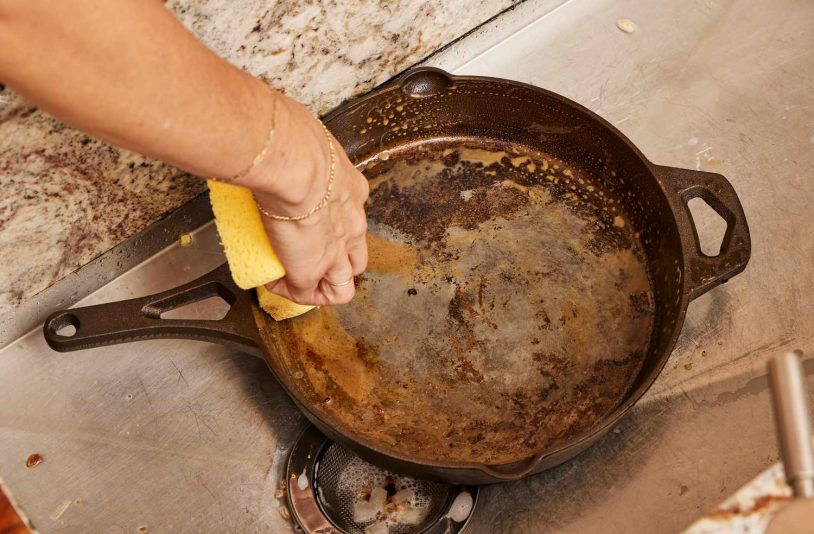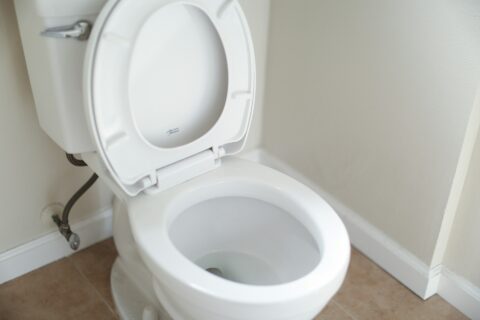
Rust on your cast iron skillet can be frustrating. It makes cooking more difficult and compromises the appearance of your trusted cookware. Many think a rusty pan is destroyed, but that’s not true.
With the proper steps, you can revive it. Learning to remove a rusty cast iron skillet will save you money and keep your pan working like new.
This guide provides simple tips for removing rust and preventing future damage.
Keep reading to rescue your skillet!
Jump to Section [Hide]
Assessing the Severity of Rust
Check if the skillet has light spots or deep pits of rust. Light rust is easier to fix, while heavy rust may require extra effort or a new pan.
Signs of light vs. heavy rust
Light rust appears as small, orange or red spots. It may feel rough, but not flaky. This type of rust is often easy to clean with a scouring pad or steel wool.
Heavy rust shows thick patches and deep flakes. The skillet might seem pitted or uneven. Proper rust removal usually requires a vinegar soak or stronger tools.
When it’s still salvageable and when to replace
Surface rust or moderate spots are easy to fix. After cleaning, your skillet can look new again with elbow grease, a steel wool brush, and seasoning cast iron. If the pan has cracks, deep pits, or holes, it’s time to replace it.
Rust that flakes off in chunks might signal irreparable damage.
Check if the surface feels solid when lightly scrubbed. Reseasoning cast iron pans after removing rust can create a nonstick surface. Severe damage weakens cookware, making it unsafe for cooking food and restoration.
Preparing for Rust Removal
Get your tools ready before starting. Keep safety in mind to protect your hands and workspace.
Supplies you’ll need
You’ll need steel wool, scouring pads, or chain mail scrubbers to clean rust. You can also use kosher salt or baking soda. For tougher spots, have a potato, distilled white vinegar, and water ready.
Use vegetable oil or shortening to re-season the skillet later. Keep dish soap handy for cleaning before the seasoning steps. Don’t forget gloves to protect your hands while working on heavy rust removal tasks!
Safety tips before you begin
Wear gloves to protect your hands. Rust removal can get messy and rough on the skin.
If you use vinegar or other chemicals, work in a well-ventilated area to avoid inhaling strong fumes. Keep kids and pets away from your workspace.
Removing Light Surface Rust
Start by scrubbing off the rust with simple tools. Use common pantry items to help loosen and lift it away.
Scrub with a steel wool or abrasive pad
Use steel wool or a scouring pad to scrub away light rust. Apply firm pressure and focus on rusty spots. If the rust is minor, this might take just a few minutes. You may need to scrub for up to an hour for stubborn areas.
Choose a stiff-bristled brush or chain mail scrubber if steel wool isn’t enough. These tools work well for cast-iron cookware, such as skillets and Dutch ovens. Always rinse thoroughly after scrubbing to remove loose particles.
Use kosher salt or baking soda as a scrubbing agent
Sprinkle kosher salt over the rusty spots on your cast iron skillet. Add a few drops of water to make a paste. Scrub with a sponge or cloth in small, circular motions until the rust loosens.
Rinse well with warm water.
For baking soda, shake it over the surface and add dish soap. Use some water to create a lather while scrubbing gently. This helps break down stuck rust without damaging the pan’s surface.
Rinse, dry completely, and re-season your skillet right after cleaning.
Removing Moderate Rust
You can handle deeper rust with simple kitchen items. A few natural methods work wonders on restoring your skillet.
Try a potato and baking soda method
Cut a potato in half. Sprinkle coarse sea salt on the skillet’s rusty spots. Scrub the surface with the cut side of the potato, pressing firmly against it. The starch helps lift rust.
For stubborn areas, sprinkle baking soda and add a drop of dish soap. Gently scrub with water until clean. Rinse thoroughly, then dry completely using low-heat drying methods to prevent re-rusting.
Re-season after cleaning to restore its non-stick surface.
Use white vinegar for a light soak
Mix equal parts of distilled white vinegar and water in a container. Soak the cast iron skillet for 15 minutes to 8 hours, but check it every 15 minutes. The vinegar breaks down rust gently without harming the cookware.
If rust is moderate, soak for an hour using the same solution. After soaking, scrub with a steel wool pad or other abrasive tools to remove any remaining rust. Rinse well and dry completely to prevent new rust from forming.
Removing Heavy Rust
Severe rust requires more robust methods of repair. To make your skillet usable again, use tougher tools and soak it.
Perform a vinegar and water soak
Mix equal parts of distilled white vinegar and water in a large container. Soak your cast iron skillet for 15 minutes to 8 hours. Check the skillet every 15 minutes to ensure it is not oversoaked, which can damage it.
If the rust is severe, leave it in the solution for one hour. After soaking, scrub away loosened rust with steel wool or an abrasive pad. Rinse well and dry thoroughly before re-seasoning the cookware.
Use a rust eraser or stronger abrasive tools
Use a rust eraser to scrub off heavy rust. These tools can handle tough spots without damaging your cast-iron skillet. If the rust is stubborn, use steel wool or chain mail scrubbers for better results.
Scrubbing might take time, and sometimes up to an hour for severe cases. Apply steady pressure and keep the surface damp as you work. Rinse often to check progress.
Preventing Rust in the Future
Dry your cast iron well after washing to keep it in top shape. A light coat of oil can shield it from moisture and rust.
Dry the skillet thoroughly
Use a clean, absorbent towel to wipe the skillet right after washing. Remove all water, as even small drops can lead to rust.
Place the skillet on a warm burner for a few minutes. This helps any hidden moisture evaporate completely. Drying thoroughly is key to preventing rust on cast iron cookware.
Apply a thin coat of oil
Rub a small amount of oil onto your cast iron skillet. For the best results, use vegetable, coconut, grapeseed, or avocado oil. Spread the oil evenly with a paper towel or cloth. Ensure that every inch, including handles and corners, is thoroughly coated.
Avoid using too much oil to prevent stickiness. A thin layer helps protect against rust and keeps the pan smooth. This step is key after thoroughly drying the cast iron to maintain its finish.
Store in a dry place
Keep your cast-iron skillet rust-free by storing it in a dry location. Moisture causes rust to form quickly, so avoid damp areas like under the sink. Use low-humidity places, and stack pots or pans with paper towels between them for extra protection.
Ensure the skillet is completely dry before storing it away. After washing, wipe off any water and leave no moisture behind. Add a light coat of high smoke-point oil, such as Crisco, to help shield it from air exposure.
Avoid soaking or using the dishwasher use
Soaking your cast iron skillet in water can cause rust. Water seeps into the tiny pores and speeds up damage. To protect it, always dry it right after cleaning.
Dishwashers, including pots, pans, and bakeware, can be too harsh for cast iron cookware. The detergent strips away seasoning, exposing the metal to moisture, and rust follows quickly.
Stick with hand washing for better care.
Re-seasoning the cast iron skillet
Apply a thin layer of high-smoke-point oil, such as vegetable or canola oil, and rub it evenly over the entire skillet, including the handle and bottom.
Preheat your oven to 425–500°F. Place the skillet upside down on a baking sheet to catch drips. Bake it for one hour. Let it cool completely before storing it with your other pots and pans.
The Bottom Line
Cleaning a rusty cast-iron skillet is simple with the proper steps. Start by checking for bad rust, then use tools like steel wool, salt, or vinegar as needed. Each method helps restore your pan and keep it useful for years to come.
Always dry and oil your skillet after cleaning to prevent future rust. A well-seasoned pan makes cooking easier and tastier every time you use it. Take care of your cast iron, and it will last a lifetime!








